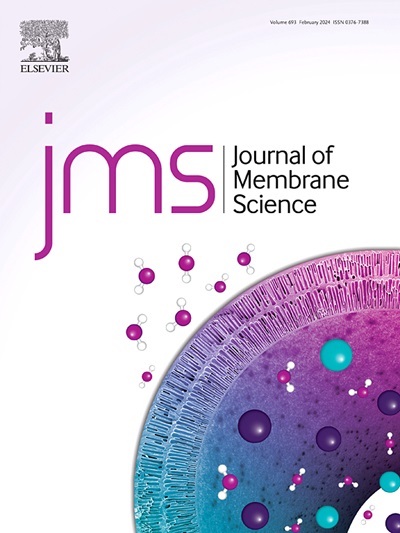ε-Polylysine regulated nanofiltration membrane with high free volume for efficient separation of dye/salt
IF 8.4
1区 工程技术
Q1 ENGINEERING, CHEMICAL
引用次数: 0
Abstract
Highly selective solute-solute separation remains a significant challenge for nanofiltration membranes, with the free-volume microstructure playing a critical role in determining perm-selectivity. This study presents a thin-film composite membrane fabricated through interfacial polymerization between bio-based ε-polylysine (ε-PL) and triformyl chloride (TMC) for efficient dye/salt separation. ε-PL, with its unique molecular chain structure and steric hindrance, slows diffusion while maintaining adequate reactivity, promoting the formation of a selective layer with an optimal free-volume. In comparison to the small-molecule lysine used as an aqueous monomer, the polyamide membrane prepared with ε-PL exhibits a larger free-volume fraction (from 15.64 % to 38.85 %), enhanced pore connectivity, and a higher molecular weight cutoff. The optimized membrane demonstrates excellent performance, including high pure water flux (99.1 L m−2 h−1), mixed solution permeate flux (58.1 L m−2 h−1), and an impressive dye/salt separation factor (up to 597.8 for NaCl/Congo Red). The design strategy outlined here offers valuable insights for developing nanofiltration membranes with tunable pore structures, particularly for dye desalination applications.

ε-聚赖氨酸调节的纳滤膜具有高自由体积,可有效分离染料/盐
高选择性的溶质-溶质分离仍然是纳滤膜面临的一个重大挑战,自由体积微观结构在决定热选择性方面起着关键作用。研究了生物基ε-聚赖氨酸(ε-PL)与三甲酰氯(TMC)的界面聚合制备的高效染料/盐分离薄膜复合膜。ε-PL以其独特的分子链结构和位阻,在减缓扩散的同时保持足够的反应活性,促进形成具有最佳自由体积的选择层。与小分子赖氨酸相比,用ε-PL制备的聚酰胺膜具有更大的自由体积分数(15.64% ~ 38.85%)、更强的孔连通性和更高的分子量切断。优化后的膜具有优异的性能,包括高纯水通量(99.1 L m−2 h−1),混合溶液渗透通量(58.1 L m−2 h−1),以及令人印象深刻的染料/盐分离系数(NaCl/刚果红高达597.8)。本文概述的设计策略为开发具有可调孔结构的纳滤膜提供了有价值的见解,特别是用于染料脱盐应用。
本文章由计算机程序翻译,如有差异,请以英文原文为准。
求助全文
约1分钟内获得全文
求助全文
来源期刊

Journal of Membrane Science
工程技术-高分子科学
CiteScore
17.10
自引率
17.90%
发文量
1031
审稿时长
2.5 months
期刊介绍:
The Journal of Membrane Science is a publication that focuses on membrane systems and is aimed at academic and industrial chemists, chemical engineers, materials scientists, and membranologists. It publishes original research and reviews on various aspects of membrane transport, membrane formation/structure, fouling, module/process design, and processes/applications. The journal primarily focuses on the structure, function, and performance of non-biological membranes but also includes papers that relate to biological membranes. The Journal of Membrane Science publishes Full Text Papers, State-of-the-Art Reviews, Letters to the Editor, and Perspectives.
 求助内容:
求助内容: 应助结果提醒方式:
应助结果提醒方式:


